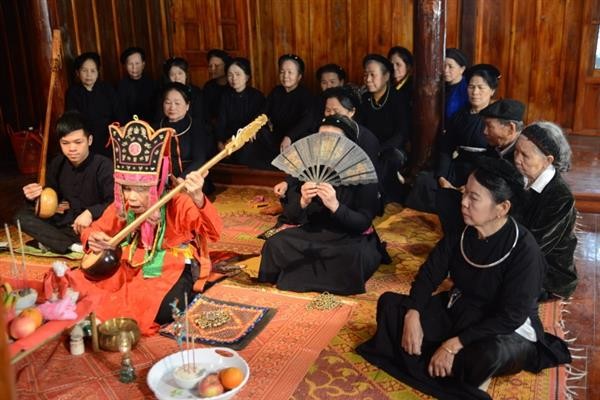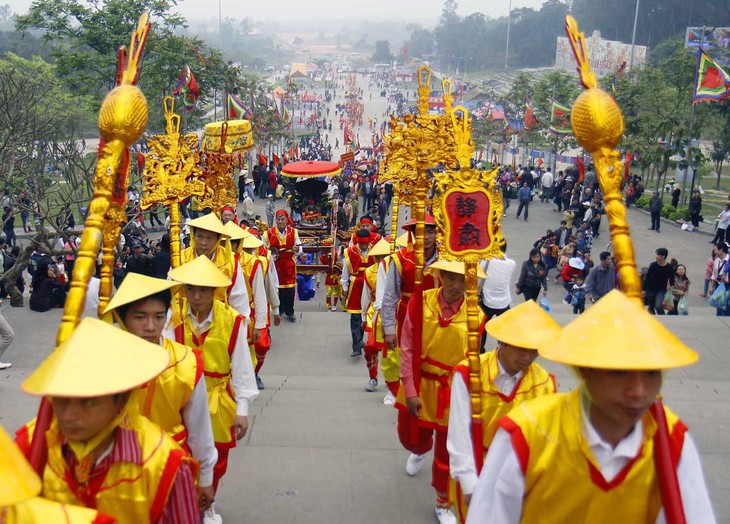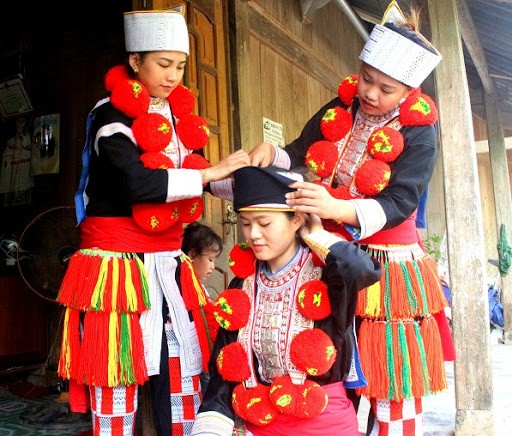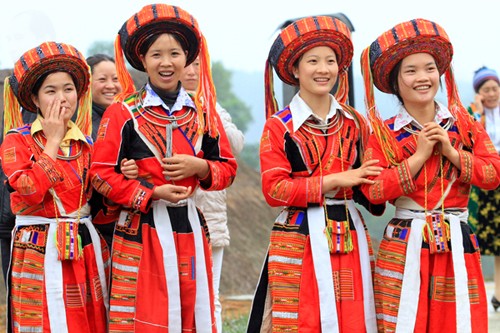B: We received many informative and interesting answers, which shows us that the writers have a profound knowledge of Vietnamese culture.
A: The heritages include the “Then” Ritual Practice of the Tay, Nung, and Thai ethnic groups; the Arts of Bai Choi in central Vietnam, the Worship of Mother Goddess of Three Realms recognized, the Hung Kings worship rituals, and the Giong Festival in Phu Dong and Soc Temple.
 "Then" Ritual Practice of the Tay, Nung and Thai ethnic groups "Then" Ritual Practice of the Tay, Nung and Thai ethnic groups |
B: Many listeners provided general information on Vietnam’s tangible and intangible cultural heritages and photos to illustrate their entries. They also took a close look at Vietnamese policies and efforts to preserve the heritages.
A: The jury were particularly impressed with the answers of Xue Fei – a Chinese listener to our Chinese section, Sergey Afanasyev – a Ukrainian listener to our Russian section, Kasem Thangthong – a Thai listener to our Thai section, C.R. Nurdin and Rudi Hartono – two Indonesian listeners to our Indonesian section, Paul Jamet – a French listener to our French section, and Johnny Antonio Ramírez López – a Peruvian listener to our Spanish section.
 The Bai Choi performance The Bai Choi performance |
B: Their answers showed a detailed knowledge of Vietnamese heritages and great affection love for Vietnam.
A: I’m reading an email from Ashik Eqbal Tokon of Bangladesh, the land of rivers, with feedback on some programs that VOV aired recently.
B: Ashik said our Culture segment talked in detail about Du Ke theater. He was surprised to learn that this form of musical theater was created in the early 1900's by Khmer people. He said: “After listening to the report, I read it on VOVworld’s website. I realized why you said it is a unique performing art of Southern Vietnam that represents Khmer cultural heritage.”
 The Hung Kings Temple Festival The Hung Kings Temple Festival |
A: Ashik said world media have talked about typhoon Molave and other storms that hit Vietnam. Last week our Village Life segment covered typhoon Molave which devastated Quang Ngai province, and how UNDP helped the recovery effort.
B: After Molave, Vietnam’s central region was hit by three more devastating typhoons. The latest one was typhoon Vamco, which battered Quang Binh, Quang Tri, and Thua Thien-Hue province.
A: The storm injured 19 people, blew the roofs off thousands of houses, damaged embankments, caused landslides along the coastline and rivers, and sank several fishing boats. The storm also destroyed electrical wires and poles, causing power outages in many communes.
B: Local authorities and volunteers are helping people repair and clean houses, schools, clinics, and offices. Localities are simultaneously preparing for the winter-spring rice crop.
A: Siddhartha Bhattacharjee of India wants to know about clothing of the Vietnamese ethnic minority groups, and which minority groups have the smallest populations.
B: Vietnam has 54 ethnic groups. Each group has traditional clothes. It’s easy to identify them by their clothes and accessories. Indigo is the main color and each group adds variations of light blue, dark blue, and blue-black. Emboidery and dyed patterns contribute to the uniqueness.
A: Red Dao costumes are particularly striking with their red and white colors. Their clothes are intricately embroidered with motifs of animals and plants. Their headdresses are often embellished with silver studs, coins, and tassels.
 Red Dao girls Red Dao girls |
B: The Flower Mong dress is a fusion of traditional craftsmanship and modern, mass-produced materials. Women and children cover themselves in a kaleidoscope of colours from head to toe using heavy pin stripe appliqué, hand embroidery, and neon-beaded fringe work.
 Traditional clothes of Flowery Mong women Traditional clothes of Flowery Mong women |
A: The Ha Nhi have two different traditional dresses, depending on where they live. The Ha Nhi of Lai Chau wear an exciting combination of multi-coloured striped sleeves, silver studded triangle details, and a headdress made from beads, ribbons, pompoms and tassels. The Lao Cai of Ha Nhi wear indigo blue and weave and dye their fabrics by hand before embroidering simple, geometric borders on the cuffs, sleeves, collar, and central panel.
 The Ha Nhi The Ha Nhi |
B: The LoLo in Ha Giang province are distinguishable when, a few times a year, they celebrate a special occasion by donning the most elaborate and decorative outfits featuring batik, appliqué, embroidery, tassels, ribbons, and buttons.
A: Of the ethnic minorities, the most numerous are the Tay, Thai, Muong, Hoa, Khmer, and Nung with populations of around 1 million each, while the least numerous are are Brau, Ro Mam, and O Du with several hundred people each.
B: The Brau used to live along the border between Vietnam, Laos and Cambodia. They were the most recent group to settle in Vietnam, about 100 years ago. The Brau live in Ngoc Hoi district, Kon Tum province. They don’t have their own alphabet but they do have their own mother tongue, a dialect of the Mon Khmer language. The Brau population is 655 this year, an increase from 417 in 2012.
 Dragon Bridge in Da Nang city Dragon Bridge in Da Nang city |
A: A listener asked us about the Dragon Bridge, an iconic structure in Da Nang city. This bridge across the Han river is named Dragon Bridge because it has the shape of a dragon and can breathe fire and water.
B: It is 666m long and has six wide lanes for traffic. It opened to traffic in 2013. The bridge was designed by the US firm Ammann & Whitney Consulting Engineers and the Louis Berger Group. This modern bridge provides the shortest route from Da Nang International Airport to My Khe and Non Nuoc beach.
A: The dragon on the bridge can breathe fire for 2 minutes or water for 3 minutes, making it one of Da Nang’s most popular attractions. The water sprays out in a powerful blast as tourists watch from coffee shops along the riverside. The many boats docked along Bach Dang street provide an other way to watch the show.
B: We always welcome your feedback at: English Service, VOVworld, the Voice of Vietnam, 45 Ba Trieu street, Hanoi, Vietnam. Or you can email us at: englishsection@vov.vn. You’re invited to visit us online at vovworld.vn, where you can hear both live and recorded programs.
A: Check out our VOV Media App, available on both the IOS and Android platform, to hear our live broadcasts. We look forward to your feedback on the mobile version of vovworld.vn. Once again, thank you all for listening.
Goodbye until next time.